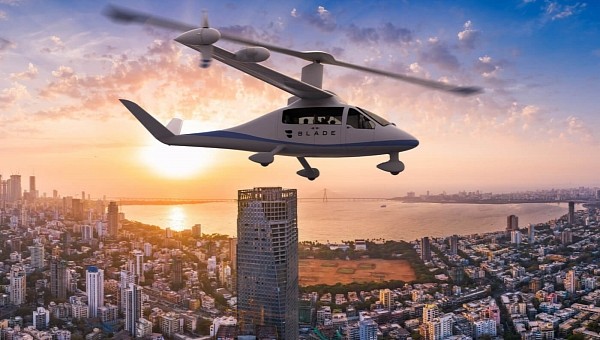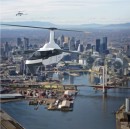It’s only a matter of time until the highly-anticipated electric air taxis will become a common sight all over the world. eVTOL (electric vertical take-off and landing) manufacturers, vertiport developers, and aviation operators are all gearing up to reach the finish line in the UAM (Urban Air Mobility) race, which will actually become the beginning of a new era.
Electric air taxis are born global – an aviation operator in Europe can choose a Chinese eVTOL, and an American design can become popular in New Zealand and Japan. There’s enormous potential for the UAM market, on a global level, and every region or country can get a piece of the pie.
Like China, India is one of the countries where this new air mobility sector can make a huge difference. Electric two-wheelers of all kinds are already a hit in India, so why not use the same advantages for air transportation? Battery-electric aircraft could drastically improve traffic and cut CO2 emissions, while also being much quieter and easier to maintain, compared to conventional helicopters.
A Texas-based company that makes its eVTOLs in Canada is ready to pioneer air taxi services in India. Its partner is FlyBlade India, a joint venture between Blade Air Mobility and Hunch Ventures.
At this point, it seems impossible to imagine 250 of these futuristic-looking contraptions flying around one country. But that’s going to happen gradually, over the years. Blade intends to begin with 150 eVTOLs, and add up to 100 more over the course of a decade.
All of the future aircraft will be coming from Jaunt Air Mobility. Jaunt is headquartered in Dallas, Texas, with Montreal, Canada, being its hub for both design and manufacturing. Its flagship aircraft was officially unveiled three years ago, in April 2020.
It’s called Journey and its specs don’t stray too far from what most eVTOLs are promising – a maximum speed of 175 mph (281 kph) for ranges between 80 and 100 miles (128-160 km). Journey’s efficiency comes from a mix of both helicopter and fixed-wing capabilities.
In other words, it can take off and land vertically, thanks to the Slowed-Rotor Compound (SRC) technology, but operate like an airplane during flight. This is also a great benefit safety-wise because even the eVTOL suffers from what is called a total loss of propulsion, but can still make it safely to the ground by gliding or auto-rotating.
The same technology is also responsible for making Journey almost completely silent. In cruise mode, the aircraft can reduce rotor speed, which leads to reduced drag, less noise, and fewer vibrations. This makes Journey ideal for operating in busy urban areas, where it can help drastically reduce pollution and noise levels, compared to standard helicopters.
Blade and Jaunt plan to officially launch air taxi operations across India by 2027, when the Journey eVTOL is expected to be fully certified.
Like China, India is one of the countries where this new air mobility sector can make a huge difference. Electric two-wheelers of all kinds are already a hit in India, so why not use the same advantages for air transportation? Battery-electric aircraft could drastically improve traffic and cut CO2 emissions, while also being much quieter and easier to maintain, compared to conventional helicopters.
A Texas-based company that makes its eVTOLs in Canada is ready to pioneer air taxi services in India. Its partner is FlyBlade India, a joint venture between Blade Air Mobility and Hunch Ventures.
At this point, it seems impossible to imagine 250 of these futuristic-looking contraptions flying around one country. But that’s going to happen gradually, over the years. Blade intends to begin with 150 eVTOLs, and add up to 100 more over the course of a decade.
All of the future aircraft will be coming from Jaunt Air Mobility. Jaunt is headquartered in Dallas, Texas, with Montreal, Canada, being its hub for both design and manufacturing. Its flagship aircraft was officially unveiled three years ago, in April 2020.
It’s called Journey and its specs don’t stray too far from what most eVTOLs are promising – a maximum speed of 175 mph (281 kph) for ranges between 80 and 100 miles (128-160 km). Journey’s efficiency comes from a mix of both helicopter and fixed-wing capabilities.
In other words, it can take off and land vertically, thanks to the Slowed-Rotor Compound (SRC) technology, but operate like an airplane during flight. This is also a great benefit safety-wise because even the eVTOL suffers from what is called a total loss of propulsion, but can still make it safely to the ground by gliding or auto-rotating.
The same technology is also responsible for making Journey almost completely silent. In cruise mode, the aircraft can reduce rotor speed, which leads to reduced drag, less noise, and fewer vibrations. This makes Journey ideal for operating in busy urban areas, where it can help drastically reduce pollution and noise levels, compared to standard helicopters.
Blade and Jaunt plan to officially launch air taxi operations across India by 2027, when the Journey eVTOL is expected to be fully certified.







